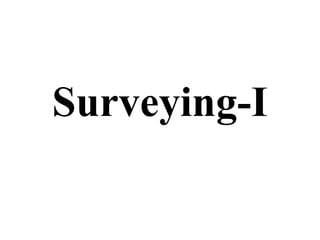
Introduction to Surveying .pptx
- 1. Surveying-I
- 2. INTRODUCTION • Surveying is the art of and science of determining the relative positions of various points or stations on the surface of the earth by measuring the horizontal and vertical distances, angles, and taking the details of these points and by preparing a map or plan to any suitable scale.
- 3. Objective of Surveying • The object of surveying is to prepare a map or plan to show the relative positions of the Objects on the surface of the earth. • The map or plan is drawn to some suitable scale. • It also Shows boundaries of districts states, and countries too. • It features different engineering building roads railways dams canals etc.
- 6. Uses of Surveying The surveying may be used for following purposes: • To prepare a topographical map which shows hills, valleys, rivers, forests, villages, towns etc. • To prepare a cadastral map which shows the boundaries of fields, plots, houses and other properties.. • To prepare an engineering map which shows the position of engineering works such as buildings, roads, railways, dams, canals.
- 7. Uses of Surveying • To prepare a contour map to know the topography of the area to find out the best possible site for roads, railways, bridges, reservoirs, canals, etc. • Surveying is also used to prepare military map, geological map, archaeological map etc. • For setting out work and transferring details from the map on the ground.
- 8. Primary Divisions of Surveying • We know that the shape of the earth is spheroidal. • Thus the surface is obviously curved. Surveying is primarily divided into two types considering the curvature of the earths surface. • Plane Surveying • Geodetic Surveying
- 9. Primary Divisions of Surveying Plain Surveying • The plain surveying is that type of surveying in which earth surface is considered as a plane and the curvature of the earth is ignored. • In such surveying a line joining any two stations is considered to be straight. • The triangle formed by any three points is considered as a plane triangle, and the angles of the triangle are considered as plain angles. • Surveying is carried out for a small area of less than 250 km2 . • It is carried out by local or state agencies like R & B department, Irrigation department, Railway department.
- 10. Plain Surveying
- 11. Geodetic Surveying • Geodetic Surveying • The geodetic Surveying is that type of surveying in which the curvature of the earth is taken into account. • It is generally extended over larger areas. • The line joining any two stations is considered as curved line. • The triangle formed by any three points is considered to be spherical and the angles of the triangle are considered to be spherical angles. • Geodetic surveying is conducted by the survey of India Department and is carried out for a larger area exceeding 250 km2
- 14. Plain Surveying Vs Geodetic Surveying The earth surface is considered as plain Surface. The earth surface is considered as Curved Surface. The Curvature of the earth is ignored The curvature of earth is taken into account. Line joining any two stations is considered to be straight The line joining any two stations is considered as spherical. The triangle formed by any three points is considered as plain The Triangle formed by any three points is considered as spherical The angles of triangle are considered as plain angles. The angles of the triangle are considered as spherical angles. Carried out for a small area < 250 km2 Carried out for a small area > 250 km2
- 15. Fundamental Principles of Surveying • Two basic principles of surveying are: • Always work from whole to the part, and • To locate a new station by at least two measurements ( Linear or angular) from fixed reference points.
- 16. Fundamental Principles of Surveying • Always work from whole to the part: • According to the first principle, the whole survey area is first enclosed by main stations (i.e.. Control stations) and main survey lines. The area is then divided into a number of divisions by forming well conditioned triangles
- 18. Fundamental Principles of Surveying • The main survey lines are measured very accurately with precise survey instruments. • The remaining sides of measured. The purpose of this method of working. The triangle are is to control accumulation of errors. • During measurement, if there is any error, then it will not affect the whole work, but if the reverse process is followed then the minor error in measurement will be magnified.
- 19. Fundamental Principles of Surveying • To locate a new station by at least two measurements ( Linear or angular) from fixed reference points. • According to the second principle the points are located by linear or angular measurement or by both in surveying. • If two control points are established first, then a new station can be located by linear measurement. Let A & B are control points, a new point C can be established.
- 20. Fundamental Principles of Surveying • Following are the methods of locating point C from such reference points A &B. • The distance AB can be measured accurately and the relative positions of the point can be then plotted on the sheet to some scale. (a) Taking linear measurement from A and B for C. (b) Taking linear measurement of perpendicular from D to C. (c) Taking one linear measurement from B and one angular measurement as ∕ABC
- 21. Fundamental Principles of Surveying • Taking two angular measurement at A & B as angles / CAB and /ABC. • Taking one angle at B as / ABC and one linear measurement from A as AC.